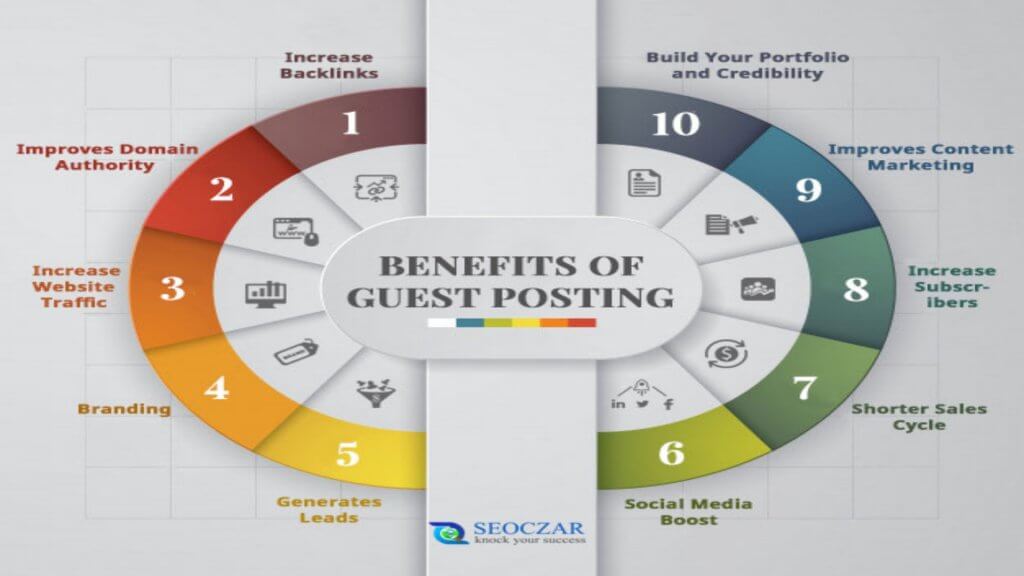
Blogger outreach can elevate your business and grow your exposure to new audiences.


Over the coming weeks, we are going to be bringing you the Ultimate Guide to Guesting Posting, and giving you an insight into aspects of guesting posting like:
Guest posts or, guest blogs are content published in the form of an article on someone else’s website. It really is that simple and it can be a key tool to growing your business and online presence!
Guest blogging is a content marketing tactic that involves writing content to publish on an existing website and include links back to your own website. Depending on where you publish your article, there will be different requirements as to what is accepted, including whether the post is tagged to say who it was written by, the amount of words and links that can be included in the article and whether it remains on the site permanently. These are all important things to check before making a guest post on a website.
A guest post can not only help marketing based roles, but any company wishing to boost its online presence, promote a product or process or reach new audiences.
[article_advert]
Within the guest posting world, there are site providers who have sites readily available to publish your content, and then the opposite, those looking for somewhere to post their content. It is a mutually beneficially exchange between the two sides and ensuring you find the correct match for your content; it can be very successful. The guest posting process is all about finding either the right content to match your site, or the right site to match your content! It is a positive element to add good quality content to your own website, or vice versa, to publish on a good quality website to build your brand awareness. With many guest post transactions there can be a money exchange and this will also need to be discussed between the two parties involved, before making your post.
During the upcoming articles in our Ultimate Guide to Guest posting, we will be delving into the actual benefits but here is a quick diagram from SEOCZAR of the 10 most beneficial elements…

To adopt this marketing tools within your own work through the form of guest posts, there are many platforms available that allow you to process a guest post on their sites and some contain multiple domains to choose from. Platform with multiple domains, do some of the hard work for you and make it easy to find somewhere suitable for your content and ensure that you will get the best results from guest posting.
Look out for the next article where we will be sharing more information on our own guest post site, BubbleSEO and other platforms.
Grow your business online with content marketing solutions from Bubble SEO today.
Place An Order
Building high-quality backlinks remains one of the most effective ways to improve your website’s search engine rankings and drive organic traffic. But with ever-evolving algorithms, it’s crucial to adopt strategies that are not only effective but also align with Google’s link-building guidelines. This complete guide breaks down proven link-building strategies that can help your business achieve sustainable growth online. Why Is Link Building Important? Links act as "votes of confidence" for your website. Search engines like Google evaluate these links to determine the authority, relevance, and trustworthiness of your content. A well-executed link-building strategy can: Improve SEO rankings: High-quality backlinks signal credibility to search engines. Increase referral traffic: Links on relevant sites can bring in targeted visitors. Enhance brand visibility: Backlinks expose your brand to wider audiences. 1. Create High-Quality Content Exceptional content is the foundation of any successful link-building campaign. Content that provides value—whether it’s in-depth guides, videos, or infographics—naturally attracts links.Consider investing in data-driven studies, industry reports, or step-by-step tutorials that solve your audience's pain points. Actionable Tip: Use tools like Google Trends and Google Keyword Planner to identify trending topics relevant to your niche. 2. Guest Posting Guest posting remains a staple for link building. By contributing articles to reputable websites within your industry, you not only earn backlinks but also establish yourself as a thought leader.At Bubble SEO, we specialize in crafting engaging guest posts that align with the host site’s audience and guidelines. How to Get Started: Research blogs in your niche using platforms like BuzzSumo or Ahrefs Content Explorer. Pitch topics that add value to their readers while subtly promoting your expertise. 3. Broken Link Building This strategy involves finding broken links on other websites and suggesting your content as a replacement. Not only do you help the site owner fix their links, but you also gain a valuable backlink. Steps: Identify broken links using tools like Check My Links or Ahrefs Broken Link Checker. Reach out to the website owner with a polite email, offering your content as an alternative. 4. Leverage Social Media and Influencers Social media platforms and influencer partnerships can amplify your link-building efforts. While links from platforms like Twitter or LinkedIn are usually no-follow, they drive traffic and encourage natural link generation.Collaborating with influencers can also boost your content’s visibility to a wider, engaged audience. Example: Work with influencers to share your high-value resources, increasing the likelihood of backlinks from their followers' websites. 5. Local Citations and Directories For local businesses, getting listed on relevant directories is an easy win. Ensure your business is added to: Google My Business Yell Trustpilot These citations often come with backlinks and improve your local SEO rankings. 6. Competitor Backlink Analysis Understanding where your competitors get their backlinks can uncover new opportunities. Tools like SEMrush and Ahrefs allow you to analyze their backlink profiles and replicate successful strategies. 7. Participate in Community Forums and Q&A Platforms Contributing to platforms like Quora, Reddit, and niche-specific forums can help you gain backlinks. Focus on providing genuine value rather than spamming links. Conclusion Effective link-building requires a combination of creativity, persistence, and strategy. By focusing on quality over quantity and adopting a diverse range of tactics, you can build a robust backlink profile that drives real results. To learn more about professional link-building services or to discuss a bespoke SEO strategy for your business, visit BubbleSEO. Let’s build better links for a brighter online future!

In the digital age, content marketing remains a cornerstone of successful online business strategies. By creating valuable, relevant, and consistent content, businesses can engage their audiences, drive website traffic, and boost sales. Whether you’re a seasoned marketer or just beginning your journey, mastering content marketing requires the right tools and techniques. Let’s explore some essentials that can help elevate your content marketing efforts. Understanding Content Marketing Fundamentals Content marketing isn’t just about producing blog posts or social media updates. It’s about delivering the right message to the right audience at the right time. To achieve this, you need a clear strategy. Here are the steps to ensure your content strategy is effective: Define Your Goals: What do you want to achieve? Increased traffic, higher engagement, or more leads? Know Your Audience: Use tools like Google Analytics to understand audience demographics and behaviour. Choose Your Platforms: Focus on where your audience spends the most time—be it LinkedIn, Instagram, or your blog. Essential Content Marketing Tools To stay ahead in a competitive digital landscape, leveraging the right tools is crucial. Here are some must-haves: SEO Tools Google Keyword Planner: Discover high-performing keywords to create targeted content. SEMRush: Analyse competitors and uncover content opportunities. Content Creation Canva: Design engaging visuals without needing advanced graphic design skills. Grammarly: Ensure your content is polished and error-free. Content Management WordPress: Manage your blog and website seamlessly. Bubble SEO: Take advantage of professional guest posting, content writing, and link-building services to amplify your marketing efforts. Social Media Scheduling Hootsuite: Schedule and analyse social media posts across platforms. Buffer: Manage your posting schedule efficiently to maximize reach. Techniques to Perfect Your Content Marketing Strategy Prioritise Quality Over QuantityIt’s better to post one high-quality article per week than several mediocre ones. Focus on providing value to your audience. Optimise for SEOEvery piece of content should be optimised for search engines. Use relevant keywords, meta descriptions, and engaging headlines to improve visibility. For expert advice, visit Bubble SEO. Leverage AnalyticsRegularly analyse your content’s performance using tools like Google Analytics. Track metrics such as page views, time on site, and conversion rates to refine your strategy. Experiment with Different FormatsDon’t limit yourself to blogs—explore videos, podcasts, infographics, and webinars to diversify your content and reach new audiences. Future-Proof Your Content Strategy As trends in digital marketing evolve, staying adaptable is key. Keep an eye on developments in artificial intelligence (AI), voice search, and interactive content. By doing so, you’ll maintain a competitive edge in an ever-changing landscape. If you’re ready to take your content marketing to the next level, explore the bespoke services offered by Bubble SEO. Their tailored solutions will ensure your content reaches the right audience at the right time, driving results that matter. Content marketing is an art and a science. By combining the right tools, techniques, and insights, you can create a strategy that not only captures attention but also fosters long-term growth for your business.

In the ever-evolving world of digital marketing, link building remains a cornerstone strategy for improving search engine rankings and driving organic traffic. As we step into 2025, staying ahead of the curve means adopting innovative and creative techniques to ensure your website stands out. Here are some fresh strategies to enhance your link-building game, with insights into how platforms like Bubble SEO can support your efforts. 1. Leverage Digital PR for High-Authority Backlinks Digital PR combines traditional public relations tactics with modern SEO strategies. By creating newsworthy content, such as original research or impactful stories, you can attract links from reputable media outlets. Partnering with agencies like CoverageBook can help you measure the effectiveness of your campaigns and identify opportunities to improve. 2. Interactive Content for Engagement and Links Interactive content, such as quizzes, calculators, and infographics, naturally attracts backlinks as people share them across platforms. Tools like Canva and Visme enable you to create visually appealing assets that engage audiences and encourage organic link sharing. 3. Focus on Resource Link Building Identify resource pages within your niche and pitch your content as a valuable addition. For instance, if you specialize in marketing, an in-depth guide on AI-driven advertising trends could be an excellent resource for industry-specific pages. 4. Utilise Niche Directories and Industry Awards Niche directories and awards sites provide an opportunity to gain high-quality backlinks. Platforms like Clutch or even industry awards run by Bubble SEO can increase your credibility and link profile while showcasing your expertise. 5. Collaborative Content and Guest Posting Collaborating with influencers or other businesses in your industry can lead to mutually beneficial backlink opportunities. Guest posting remains a tried-and-true method, but ensure that your content provides unique value. Bubble SEO’s guest posting services can connect you with relevant publishers for impactful link placements. 6. Repurpose Existing Content Turn blog posts into videos, podcasts, or presentations to target different audiences. Platforms like SlideShare allow you to share these resources, generating backlinks from users who embed your content on their sites. 7. Monitor Competitor Backlinks Analyzing your competitors’ backlinks can reveal untapped opportunities. Tools like Ahrefs and SEMrush can help identify which sites link to your competitors, enabling you to reach out with your own content. 8. Host Webinars or Virtual Events Webinars and virtual events provide valuable educational content that attendees may link to when sharing their insights. Record these sessions and offer on-demand access, creating evergreen content that continues to generate backlinks over time. 9. Create Tools or Templates Develop free tools or templates that solve a common problem in your industry. For example, marketing calculators or downloadable content calendars can attract backlinks from businesses and individuals referencing your resources. 10. Engage in Community Forums and Q&A Sites While not a direct link-building strategy, contributing valuable insights on forums like Reddit or Quora can lead to organic backlinks. These platforms allow you to build relationships and establish authority in your niche. Conclusion Link building in 2025 is all about creativity, authenticity, and value-driven content. By adopting these innovative techniques, you can stay ahead of the competition and build a robust backlink profile. Platforms like Bubble SEO are here to help, offering tailored solutions to meet your unique marketing needs. Start implementing these strategies today, and watch your SEO efforts flourish!

Brand awareness is the recognition of a brand or business by its name, logo, or any other defining features

What Does SEO Stand For? In today’s digital world, being visible on Google is one of the most crucial steps toward growing your business. One of the key ways Google determines how to rank your website is through SEO. SEO stands for Search Engine Optimisation. In simple terms, it’s the process of improving your website so that search engines like Google recognise it as relevant to the search terms people use. There are many ways to improve your SEO, including using the right keywords, securing high-quality backlinks, and creating helpful content. It’s often about understanding how to implement these elements effectively. Why Is SEO Important for Your Website? Maintaining a strong online presence is vital for any business. A higher position on Google’s search results can significantly increase your website traffic, engagement, and conversions. Think about your own browsing habits—how often do you go past the first page of Google results? Probably not often. Businesses on page two and beyond are much less likely to be seen and, therefore, are more likely to be overlooked in favour of competitors with better rankings. SEO is particularly important for e-commerce businesses. With so many companies selling similar products, having a higher ranking can make the difference between making a sale and losing out to a competitor. How Search Engines Work (In Plain English) So, how does Google know what your website is about? Google uses automated programs called bots or crawlers to scan the internet. These bots check your site for updated and new content—everything from webpages and blog posts to images, videos, and even PDFs. Once this content is scanned (or "crawled"), it gets indexed—meaning it’s stored in Google’s database. Then, when someone makes a relevant search, Google refers to this index to deliver the most relevant results. For example, if someone searches for marketing agency, a website that frequently uses this phrase and includes relevant content is far more likely to rank highly than, say, a gardening business. The 3 Main Pillars of SEO There are three main areas of SEO that you should focus on to improve your website’s performance: 1. On-Page SEO This covers everything that’s physically on your website, such as: Keywords Page titles Meta titles & descriptions Image alt text and captions By optimising these elements, you help Google understand what your site is about and show that your content is current and relevant. Tools like Yoast SEO can help guide you through the process. 2. Off-Page SEO Off-page SEO refers to actions taken outside of your own website to influence your rankings. This includes: Earning backlinks from reputable sites Building a strong social media presence Collaborating with online influencers or publishing guest posts These efforts help build your site’s authority, signalling to Google that others trust and value your content. 3. Technical SEO Technical SEO focuses on the backend of your website. Key areas include: Page speed: A slow-loading website can increase bounce rates. Mobile friendliness: With mobile browsing dominating web traffic, your site must perform well on smaller screens. Use Google’s Mobile-Friendly Test to check. Secure browsing (HTTPS): Google prioritises websites with secure connections. If your technical setup is poor, even great content may not get the visibility it deserves. How Long Does SEO Take to Show Results? Unfortunately, SEO isn’t a quick fix—it takes time to build momentum. According to Semrush, it can take between 4 to 12 months to see measurable improvements, but this can vary depending on your site, niche, and competition. Factors such as the age of your domain, quality of your content, and how active your competitors are all play a role. For newer websites, Google’s John Mueller has stated it can take up to a year for Google to fully understand and rank your content. SEO Is a Long Game—But It Works In a world where digital visibility is everything, SEO remains one of the most powerful tools for business growth. It may require patience, ongoing effort, and a bit of learning, but the long-term benefits are well worth it. At Bubble SEO, we offer three core services to help you climb the rankings and stay ahead: Link building Content writing Guest posting Whether you're just starting out or looking to sharpen your current strategy, we’re here to support your SEO journey.

The world of SEO is constantly evolving, and staying on top of the latest trends is critical to maintaining online visibility and driving traffic. As we move through this year, some key SEO shifts have emerged that are reshaping the way businesses approach search engine optimisation. Whether you're a content creator, business owner, or digital marketer, these are the SEO trends you can't afford to overlook. 1. Link Building is Evolving Link building remains a core component of SEO, but it's becoming more sophisticated. Google’s algorithms are placing a greater emphasis on the quality and relevance of backlinks rather than sheer quantity. Building relationships with authoritative websites through guest posting and earning editorial links are now essential strategies for creating strong, natural backlink profiles. The focus should be on acquiring links that are relevant to your niche and will offer real value to users. 2. The Power of Content Continues to Grow Quality content is still king, but search engines are becoming smarter about recognising well-researched, authoritative, and relevant information. SEO now demands content that not only addresses user queries but also provides a deeper, more engaging experience. Guest posting is an effective way to distribute this high-quality content, enabling brands to reach new audiences while securing valuable backlinks. 3. User Experience (UX) and SEO Are Now Inseparable With the introduction of Google's Core Web Vitals, the overall user experience has become a critical ranking factor. Fast loading times, mobile-friendliness, and smooth navigation are now essential for SEO success. This means that your site must not only be optimised for search engines but also deliver an excellent user experience to keep visitors engaged. 4. Voice Search Optimisation Voice search is growing rapidly with the increased use of smart speakers and mobile assistants like Siri and Alexa. To stay competitive, SEO strategies need to accommodate more natural, conversational language that aligns with how people use voice search. This trend emphasises the importance of long-tail keywords and question-based content. 5. The Rise of AI in SEO AI-powered tools and algorithms are influencing SEO in unprecedented ways. Google's AI algorithm, RankBrain, helps determine the most relevant search results based on user intent, making it critical to understand the audience’s needs and craft content accordingly. SEO professionals must now consider how AI-driven features, like natural language processing and predictive search, will impact their strategies. 6. Local SEO Becomes More Prominent Local SEO continues to grow in importance, especially for small businesses. Google My Business listings, reviews, and local citations now play a significant role in helping companies appear in location-based searches. If you haven't yet optimised your site and content for local searches, this trend can no longer be ignored. The SEO landscape is always in flux, and staying on top of these trends is crucial for maintaining a competitive edge. Whether through advanced link building, guest posting, improving user experience, or leveraging AI, businesses need to adapt their strategies to the evolving digital ecosystem. By focusing on quality and relevance in every aspect of SEO, you’ll be better positioned for long-term success in search rankings.

Guest posting has long been hailed as a cornerstone strategy in SEO and content marketing. By strategically placing your content on relevant websites, you not only enhance your brand's visibility but also establish authority in your industry. This comprehensive guide will walk you through the essentials of guest posting, helping you harness its power to drive traffic and boost your SEO efforts. Understanding the Basics Guest posting involves creating and publishing content on other websites within your niche. It allows you to reach a broader audience that may not be familiar with your brand yet. The key to successful guest posting lies in choosing reputable sites that align with your industry and target audience. Steps to Successful Guest Posting Research and Targeting: Begin by identifying websites that accept guest posts and are relevant to your industry. Look for sites with a strong domain authority (DA) and a good reputation in your niche. Content Creation: Craft high-quality content that provides value to the readers of the host site. Focus on delivering insights, actionable tips, or industry trends that demonstrate your expertise. Keyword Optimisation: Integrate relevant keywords naturally into your content to enhance its SEO value. Avoid over-optimisation and prioritise readability and value to the reader. Link Strategy: Include links back to your own website strategically within the guest post. These links should be relevant and add value to the content, directing readers to relevant resources or further information. Engagement and Promotion: Once published, actively engage with the audience through comments and social media. Promote the guest post on your own channels to drive traffic back to the host site and increase exposure. Benefits of Guest Posting SEO Boost: Gain valuable backlinks that enhance your website's authority and search engine rankings. Increased Traffic: Drive targeted traffic from the host site to your own, expanding your reach and potential customer base. Brand Awareness: Establish yourself as a thought leader in your industry, building trust and credibility among your target audience. Conclusion Guest posting remains a potent tool in the arsenal of digital marketers and SEO specialists. By following these steps and consistently delivering high-quality content, you can effectively build authority, drive traffic, and elevate your brand's visibility in the competitive online landscape. For more insights into SEO, guest posting, and content marketing, visit Bubble SEO and explore our comprehensive resources.